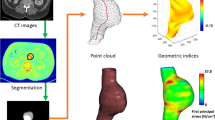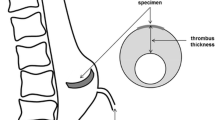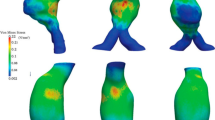Abstract
Ascending thoracic aortic aneurysms (ATAAs) are a silent disease, ultimately leading to dissection or rupture of the arterial wall. There is a growing consensus that diameter information is insufficient to assess rupture risk, whereas wall stress and strength provide a more reliable estimate. The latter parameters cannot be measured directly and must be inferred through biomechanical assessment, requiring a thorough knowledge of the mechanical behaviour of the tissue. However, for healthy and aneurysmal ascending aortic tissues, this knowledge remains scarce. This study provides the geometrical and mechanical properties of the ATAA of six patients with unprecedented detail. Prior to their ATAA repair, pressure and diameter were acquired non-invasively, from which the distensibility coefficient, pressure–strain modulus and wall stress were calculated. Uniaxial tensile tests on the resected tissue yielded ultimate stress and stretch values. Parameters for the Holzapfel–Gasser–Ogden material model were estimated based on the pre-operative pressure–diameter data and the post-operative stress–stretch curves from planar biaxial tensile tests. Our results confirmed that mechanical or geometrical information alone cannot provide sufficient rupture risk estimation. The ratio of physiological to ultimate wall stress seems a more promising parameter. However, wall stress estimation suffers from uncertainties in wall thickness measurement, for which our results show large variability, between patients but also between measurement methods. Our results also show a large strength variability, a value which cannot be measured non-invasively. Future work should therefore be directed towards improved accuracy of wall thickness estimation, but also towards the large-scale collection of ATAA wall strength data.







Similar content being viewed by others
References
Azadani AN, Chitsaz S, Mannion A, Mookhoek A, Wisneski A, Guccione JM, Hope MD, Ge L, Tseng EE (2013) Biomechanical properties of human ascending thoracic aortic aneurysms. Annals Thorac. Surg. 96(1):50–58. doi:10.1016/j.athoracsur.2013.03.094
Chau KH, Elefteriades JA (2013) Natural history of thoracic aortic aneurysms: size matters, plus moving beyond size. Prog Cardiovasc Dis 56(1):74–80. doi:10.1016/j.pcad.2013.05.007
Chow MJ, Zhang Y (2011) Changes in the mechanical and biochemical properties of aortic tissue due to cold storage. J Surg Res 171(2):434–442. doi:10.1016/j.jss.2010.04.007
Davies RR, Gallo A, Coady MA, Tellides G, Botta DM, Burke B, Coe MP, Kopf GS, Elefteriades JA (2006) Novel measurement of relative aortic size predicts rupture of thoracic aortic aneurysms. Ann Thorac Surg 81(1):169–177. doi:10.1016/j.athoracsur.2005.06.026
Duprey A, Khanafer K, Schlicht M, Avril S, Williams D, Berguer R (2010) In vitro characterisation of physiological and maximum elastic modulus of ascending thoracic aortic aneurysms using uniaxial tensile testing. Eur J Vasc Endovasc Surg 39(6):700–707. doi:10.1016/j.ejvs.2010.02.015
Duprey A, Trabelsi O, Vola M, Favre JP, Avril S (2016) Biaxial rupture properties of ascending thoracic aortic aneurysms. Acta Biomater. doi:10.1016/j.actbio.2016.06.028
Elefteriades JA, Sang A, Kuzmik G, Hornick M (2015) Guilt by association: paradigm for detecting a silent killer (thoracic aortic aneurysm). Open Heart. doi:10.1136/openhrt-2014-000169
Fehervary H, Smoljkić M, Vander Sloten J, Famaey N (2016) Planar biaxial testing of soft biological tissue using rakes: a critical analysis of protocol and fitting process. J Mech Behav Biomed Mater. doi:10.1016/j.jmbbm.2016.01.011
Ferrari G, Kozarski M, Zieliński K, Fresiello L, Di Molfetta A, Górczyńska K, Pałko KJ, Darowski M (2012) A modular computational circulatory model applicable to VAD testing and training. J Artif Organs 15(1):32–43. doi:10.1007/s10047-011-0606-4
Fillinger MF, Marra SP, Raghavan ML, Kennedy FE (2003) Prediction of rupture risk in abdominal aortic aneurysm during observation: wall stress versus diameter. J Vasc Surg 37(4):724–732. doi:10.1067/mva.2003.213
Fresiello L, Zieliński K, Jacobs S, Di Molfetta A, Pałko KJ, Bernini F, Martin M, Claus P, Ferrari G, Trivella MG, Górczyńska K, Darowski M, Meyns B, Kozarski M (2014) Reproduction of continuous flow left ventricular assist device experimental data by means of a hybrid cardiovascular model with baroreflex control. Artif Organs 38(6):456–468. doi:10.1111/aor.12178
García-Herrera CM, Atienza JM, Rojo FJ, Claes E, Guinea GV, Celentano DJ, García-Montero C, Burgos RL (2012) Mechanical behaviour and rupture of normal and pathological human ascending aortic wall. Med Biol Eng Comput 50(6):559–566. doi:10.1007/s11517-012-0876-x
Gasser TC, Ogden RW, Holzapfel GA (2006) Hyperelastic modelling of arterial layers with distributed collagen fibre orientations. J R Soc Interface 3(6):15–35. doi:10.1098/rsif.2005.0073
Gasser TC, Auer M, Labruto F, Swedenborg J, Roy J (2010) Biomechanical rupture risk assessment of abdominal aortic aneurysms : model complexity versus predictability of finite element simulations. Eur J Vasc Endovasc Surg 40(2):176–185. doi:10.1016/j.ejvs.2010.04.003
Haskett D, Johnson G, Zhou A, Utzinger U, Vande Geest J (2010) Microstructural and biomechanical alterations of the human aorta as a function of age and location. Biomech Model Mechanobiol 9(6):725–736. doi:10.1007/s10237-010-0209-7
Iliopoulos DC, Kritharis EP, Giagini AT, Papadodima SA, Sokolis DP (2009) Ascending thoracic aortic aneurysms are associated with compositional remodeling and vessel stiffening but not weakening in age-matched subjects. J Thorac Cardiovasc Surg 137(1):101–109. doi:10.1016/j.jtcvs.2008.07.023
Joldes GR, Miller K, Wittek A, Doyle BJ (2015) A simple, effective and clinically applicable method to compute abdominal aortic aneurysm wall stress. J Mech Behav Biomed Mater. doi:10.1016/j.jmbbm.2015.07.029
Khanafer K, Duprey A, Zainal M, Schlicht M, Williams D, Berguer R (2011) Determination of the elastic modulus of ascending thoracic aortic aneurysm at different ranges of pressure using uniaxial tensile testing. J Thorac Cardiovasc Surg 142(3):682–686. doi:10.1016/j.jtcvs.2010.09.068
Koullias G, Modak R, Tranquilli M, Korkolis DP, Barash P, Elefteriades JA (2005) Mechanical deterioration underlies malignant behavior of aneurysmal human ascending aorta. J Thorac Cardiovasc Surg 130(3):677. doi:10.1016/j.jtcvs.2005.02.052
Krishnan K, Ge L, Haraldsson H, Hope MD, Saloner DA (2015) Ascending thoracic aortic aneurysm wall stress analysis using patient-specific finite element modeling of in vivo magnetic resonance imaging. Interact Cardiovasc Thorac Surg 21:471–480. doi:10.1093/icvts/ivv186
Martin C, Sun W, Pham T, Elefteriades J (2013) Predictive biomechanical analysis of ascending aortic aneurysm rupture potential. Acta Biomater 9(12):9392–9400. doi:10.1016/j.actbio.2013.07.044
Martin C, Sun W, Primiano C, McKay R, Elefteriades J (2013b) Age-dependent ascending aorta mechanics assessed through multiphase CT. Ann Biomed Eng 41(12):1199–1216. doi:10.1016/j.micinf.2011.07.011.Innate
Martufi G, Gasser TC, Appoo JJ, Di Martino ES (2014) Mechano-biology in the thoracic aortic aneurysm: a review and case study. Biomech Model Mechanobiol 13(5):917–928. doi:10.1007/s10237-014-0557-9
Martufi G, Forneris A, Appoo JJ, Di Martino ES (2015) Is there a role for biomechanical engineering in helping to elucidate the risk profile of the thoracic aorta? Ann Thorac Surg 101(1):390–398. doi:10.1016/j.athoracsur.2015.07.028
Nichols M, Townsend N, Scarborough P, Rayner M (2012) European cardiovascular disease statistics 2012. September. ISBN:978-2-9537898-1-2
Niestrawska JA, Cohnert TU, Holzapfel GA (2016) Mechanics and microstructure of healthy human aortas and AAA tissues : experimental analysis and modeling. In: ECCOMAS Congress 2016
Ogden RW (2009) Anisotropy and nonlinear elasticity in arterial wall mechanics. In: Holzapfel GA, Ogden RW (eds) Biomechanical modelling at the molecular, cellular and tissue levels, vol 508. Springer, Vienna, pp 179–258. doi:10.1007/978-3-211-95875-9_3
Okamoto RJ, Xu H, Kouchoukos NT, Moon MR, Sundt TM (2003) The influence of mechanical properties on wall stress and distensibility of the dilated ascending aorta. J Thorac Cardiovasc Surg 126(3):842–850. doi:10.1016/S0022-5223(03)00728-1
Pape LA, Tsai TT, Isselbacher EM, Oh JK, O’Gara PT, Evangelista A, Fattori R, Meinhardt G, Trimarchi S, Bossone E, Suzuki T, Cooper JV, Froehlich JB, Nienaber CA, Eagle KA (2007) Aortic diameter> = 5.5 cm is not a good predictor of type a aortic dissection: observations from the International Registry of Acute Aortic Dissection (IRAD). Circulation 116(10):1120–1127. doi:10.1161/CIRCULATIONAHA.107.702720
Pasta S, Phillippi JA, Tsamis A, D’Amore A, Raffa GM, Pilato M, Scardulla C, Watkins SC, Wagner WR, Gleason TG (2015) Constitutive modeling of ascending thoracic aortic aneurysms using microstructural parameters. Med Eng Phys. doi:10.1016/j.medengphy.2015.11.001
Pierce DM, Maier F, Weisbecker H, Viertler C, Verbrugghe P, Famaey N, Fourneau I, Herijgers P, Holzapfel GA (2015) Human thoracic and abdominal aortic aneurysmal tissues: damage experiments, statistical analysis and constitutive modeling. J Mech Behav Biomed Mater 41:92–107. doi:10.1016/j.jmbbm.2014.10.003
Raghavan ML, Hanaoka MM, Kratzberg JA, Lourdes MD, Simao E (2011) Biomechanical failure properties and microstructural content of ruptured and unruptured abdominal aortic aneurysms. J Biomech 44(13):2501–2507. doi:10.1016/j.jbiomech.2011.06.004
Shang EK, Nathan DP, Sprinkle SR, Vigmostad SC, Fairman RM, Bavaria JE, Gorman RC, Gorman JH, Chandran KB, Jackson BM (2013) Peak wall stress predicts expansion rate in descending thoracic aortic aneurysms. Ann Thorac Surg 95(2):593–598. doi:10.1016/j.athoracsur.2012.10.025
Sinnecker T, Mittelstaedt P, Do J (2012) Multiple sclerosis lesions and irreversible brain tissue damage. Arch Neurol 69(6):739–745. doi:10.1001/archneurol.2011.2450
Smoljkić M, Vander Sloten J, Segers P, Famaey N (2015) Non-invasive, energy-based assessment of patient-specific material properties of arterial tissue. Biomech Model Mechanobiol 14(5):1045–1056
Sommer G, Sherifova S, Oberwalder PJ, Dapunt OE, Ursomanno PA, DeAnda A, Griffith BE, Holzapfel GA (2016) Mechanical strength of aneurysmatic and dissected human thoracic aortas at different shear loading modes. J Biomech. doi:10.1016/j.jbiomech.2016.02.042
Stemper BD, Yoganandan N, Stineman MR, Gennarelli TA, Baisden JL, Pintar FA (2007) Mechanics of fresh, refrigerated, and frozen arterial tissue. J Surg Res 139:236–242. doi:10.1016/j.jss.2006.09.001
Trabelsi O, Davis FM, Rodriguez-Matas JF, Duprey A, Avril S (2015) Patient specific stress and rupture analysis of ascending thoracic aneurysms. J Biomech 48(10):1836–1843. doi:10.1016/j.jbiomech.2015.04.035
Trablesi O, Duprey A, Favre JP, Avril S (2016) Predictive models with patient specific material properties for the biomechanical behavior of ascending thoracic aneurysms. Ann Biomed Eng 44(1):84–98. doi:10.1007/s10439-015-1374-8
Vande Geest JP, Di Martino ES, Bohra A, Makaroun MS, Da Vorp (2006) A biomechanics-based rupture potential index for abdominal aortic aneurysm risk assessment: demonstrative application. Ann NY Acad Sci 1085:11–21. doi:10.1196/annals.1383.046
Venkatasubramaniam AK, Fagan MJ, Mehta T, Mylankal KJ, Ray B, Kuhan G, Chetter IC, McCollum PT (2004) A comparative study of aortic wall stress using finite element analysis for ruptured and non-ruptured abdominal aortic aneurysms. Eur J Vasc Endovasc Surg 28(2):168–176. doi:10.1016/j.ejvs.2004.03.029
Venkatasubramanian RT, Grassel ED, Barocas VH, Lafontaine D, Bischof JC (2006) Effects of freezing and cryopreservation on the mechanical properties of arteries. Ann Biomed Eng 34(5):823–832. doi:10.1007/s10439-005-9044-x
Vorp DA, Schiro BJ, Ehrlich MP, Juvonen TS, Ergin MA, Griffith BP (2003) Effect of aneurysm on the tensile strength and biomechanical behavior of the ascending thoracic aorta. Ann Thorac Surg 75(4):1210–1214. doi:10.1016/S0003-4975(02)04711-2
Weisbecker H, Pierce DM, Regitnig P, Holzapfel GA (2012) Layer-specific damage experiments and modeling of human thoracic and abdominal aortas with non-atherosclerotic intimal thickening. J Mech Behav Biomed Mater 12:93–106. doi:10.1016/j.jmbbm.2012.03.012
Xiong J, Wang M, Zhou W, Wu JG (2008) Measurement and analysis of ultimate mechanical properties, stress-strain curve fit, and elastic modulus formula of human abdominal aortic aneurysm and nonaneurysmal abdominal aorta. J Vasc Surg 48(1):189–195. doi:10.1016/j.jvs.2007.12.053
Acknowledgments
The authors would like to thank Liberia Fresiello for generating the aortic pressure waveforms.
Funding This study was funded by a research project (G093211N) of the Research Foundation-Flanders (FWO) and a postdoctoral fellowship of FWO.
Author information
Authors and Affiliations
Corresponding author
Ethics declarations
Conflict of interest
The authors declare that they have no conflict of interest.
Rights and permissions
About this article
Cite this article
Smoljkić, M., Fehervary, H., Van den Bergh, P. et al. Biomechanical Characterization of Ascending Aortic Aneurysms. Biomech Model Mechanobiol 16, 705–720 (2017). https://doi.org/10.1007/s10237-016-0848-4
Received:
Accepted:
Published:
Issue Date:
DOI: https://doi.org/10.1007/s10237-016-0848-4




